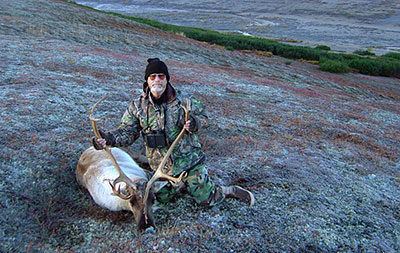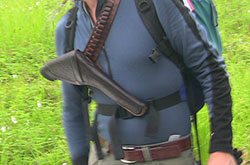Alaska Fish & Wildlife News
January 2015
Guns and Canada
Crossing the Border

Hundreds of hunters are failing to declare their firearms when they enter Canada. They are getting arrested and fined, and the U.S. Department of State wants to help.
Geoff Martineau works at the Department of State, Bureau of Consular Affairs, Office of American Citizen Services. “We help U.S. citizens traveling abroad avoid problems,” he said. “In Canada, we’re looking at an estimated 200 to 300 U.S. citizens each year who run into trouble for failing to declare their firearms. Vancouver is the single largest port of entry where this occurs, and it’s a good possibility many of these travelers are headed to Alaska.”
Martineau mentioned that it’s common to see U.S. citizens, en route to Alaska for some hunting, stopped at the border as they try to transit with firearms that are presumably rifles and shotguns.
It’s difficult to get a handle on exact figures as most of the detentions aren’t reported, he said, but it seems most pay a large fine and are turned around at the border. He’s heard some go through lengthy court proceedings, have their cars impounded and their firearms confiscated.
When crossing the border into Canada, hunters must declare all firearms in their possession. Declared rifles and shotguns may be carried through Canada while in transit to Alaska. Certain types of handguns are not permitted in Canada under any circumstances. Other handguns may be carried into Canada under certain circumstances.
Declaring firearms involves filling out some paperwork, specifically Form 5589, the Non-Resident Firearm Declaration form. There is a $25 fee, payable in Canadian funds or with a credit card. The form is available at the border, or can be downloaded in advance from the Canadian Firearms Centre website (more details on that are offered at the end of the article). The form must be presented in triplicate and signed in front of a CBSA officer at the border (it is not possible to make photocopies at the border, so it will save time and effort to do some of the work in advance. Just be sure to wait until the border to sign in front of a customs officer).
According to the Canadian Firearms Centre, completing the paperwork also allows you to bring in ammunition for that firearm for personal use.
Martineau said that regarding ammunition, there have been many cases worldwide where American travelers arrive at a foreign destination with a single bullet somewhere in their luggage that they didn’t realize was there, and they get into trouble. He advised: Don’t use the same luggage for hunting as you do for other international travel.
Canadian law requires that officials confiscate any firearms, ammunition, and other weapons from persons crossing the border who deny having the items in their possession. Confiscated firearms, ammunition, and weapons are not returned. Possession of an undeclared firearm may result in arrest and imprisonment. Travelers are strongly advised to inspect all belongings thoroughly prior to travel to Canada to avoid the accidental import of firearms or ammunition.
Canada has three classes of firearms: non-restricted, restricted, and prohibited.

Non-restricted firearms include most ordinary hunting rifles and shotguns. These may be brought temporarily into Canada for sporting or hunting use during hunting season, use in competitions, in-transit movement through Canada, or personal protection against wildlife in remote areas of Canada. Anyone wishing to bring hunting rifles into Canada must be at least 18 years old; properly store the firearm for transport; and follow the declaration requirements.
Restricted firearms are primarily handguns. While they are not firearms, pepper spray, mace, and some knives also are included in this category. A restricted firearm may be brought into Canada, but an Authorization to Transport permit must be obtained in advance from a Provincial or Territorial Chief Firearms Officer. The permit allows a handgun to be in transit, for example to Alaska, but a permit would not be issued to someone simply vacationing in Canada.
Prohibited firearms include fully automatic, converted automatics and certain military style weapons, including weapons designed for civilian use. A full list of prohibited weapons is available on the Canadian Firearms Centre website. Prohibited firearms are not allowed into Canada. Handguns with a barrel length of less than 105 mm, about 4 1/8 inches, are completely prohibited, and .25 and .32 caliber handguns are prohibited.
The Non-Resident Firearm Declaration (form RCMP 5589).
The best source for more information on carrying firearms into or through Canada the Royal Canadian Mounted Police website, or a call to the Canada Firearms Center at 1-800-731-4000; request Extension #9026 if you will be entering Canada at the Alberta border and Extension #9530 if entering from British Columbia.
U.S. citizens may find it helpful to register firearms with U.S. Customs before traveling through Canada in order to prove ownership.
Martineau said the Department of State gives detailed information for American travelers, covering safety, health, and legal issues worldwide, and specifically target certain at risk travelers. The website is here.
The State Department’s website offers some information on Canada specifically.
The Alaska Department of Fish and Game website offers some information about firearms in Alaska and traveling in Canada with guns.
Subscribe to be notified about new issues
Receive a monthly notice about new issues and articles.
